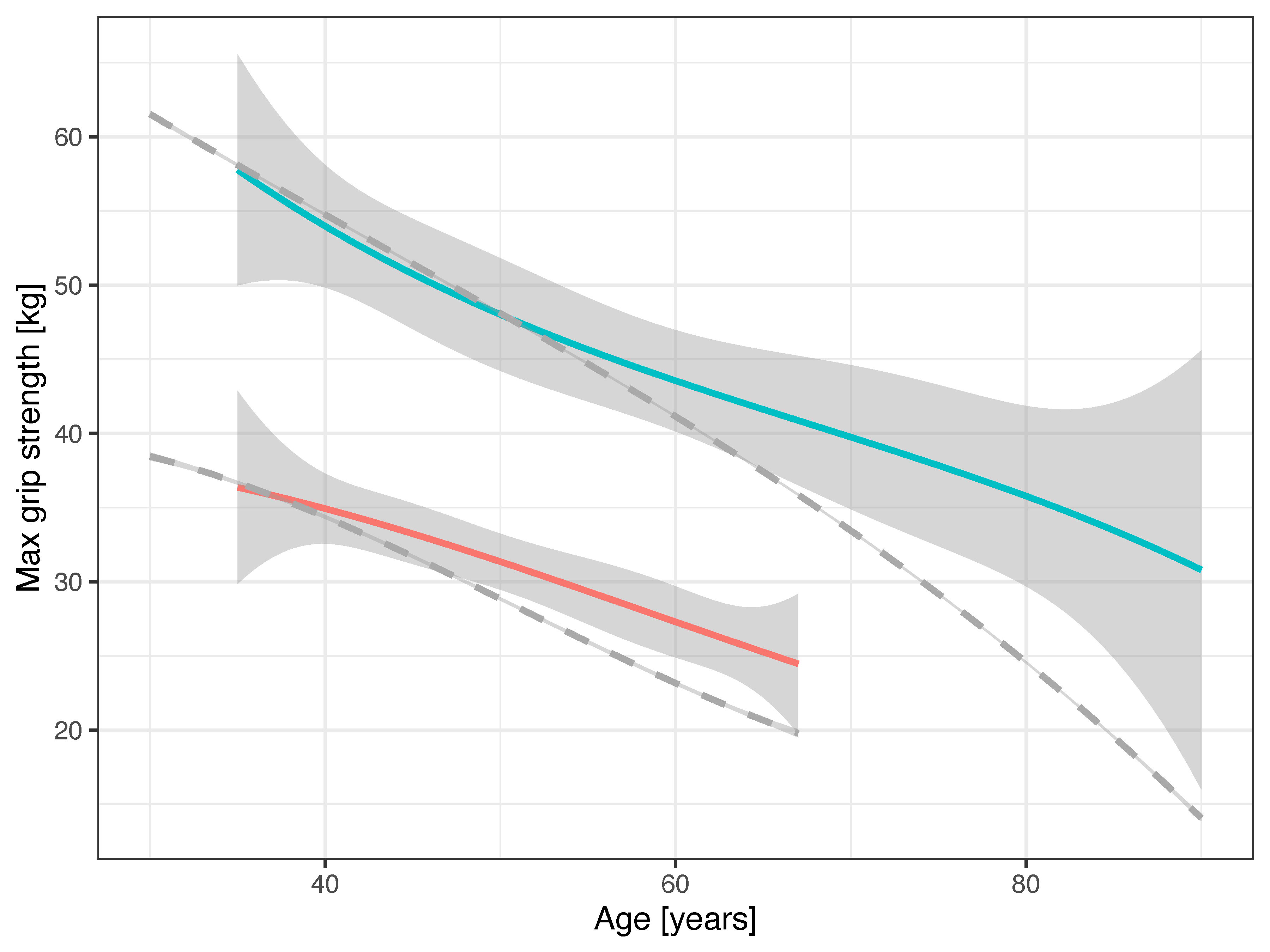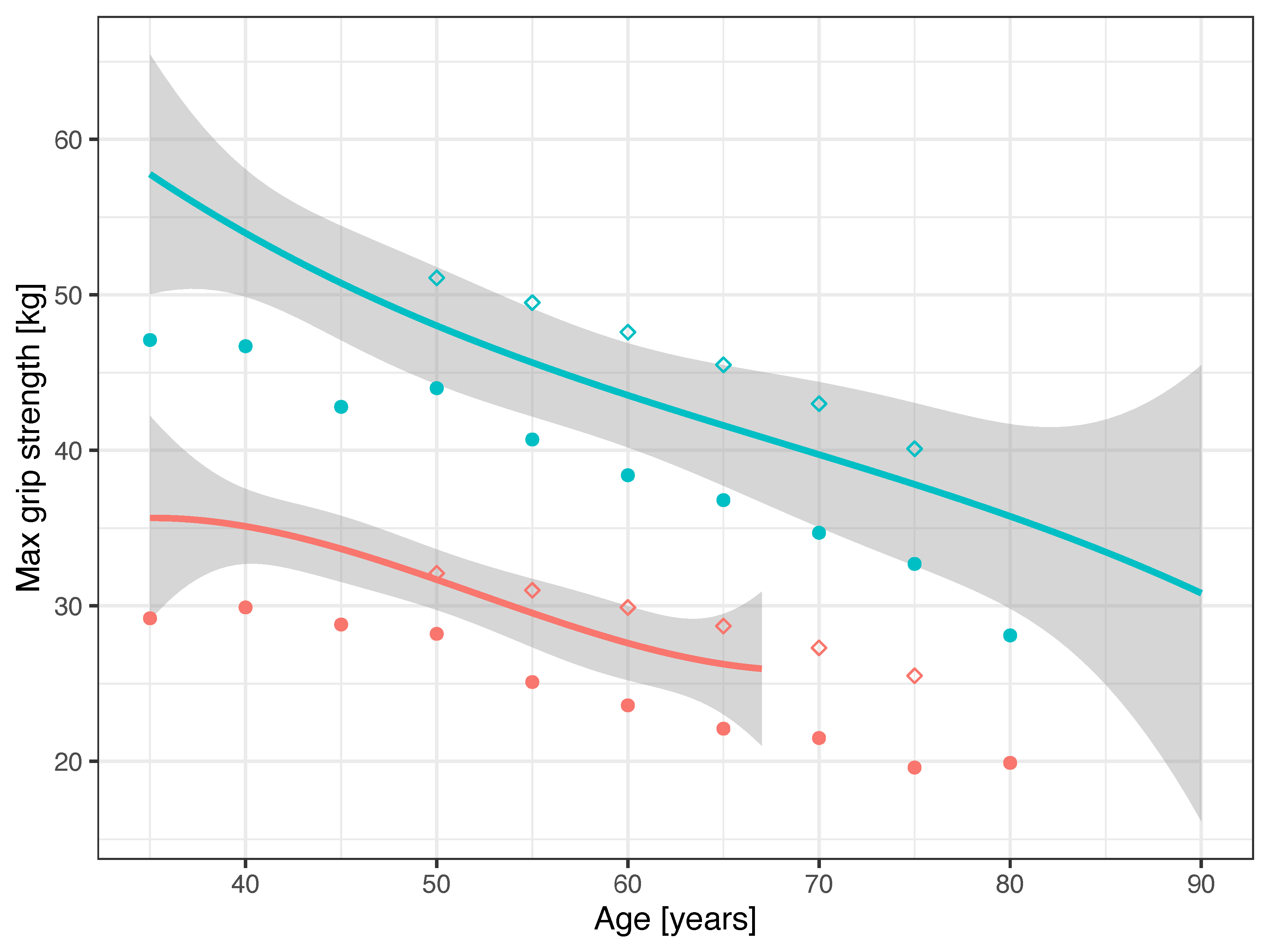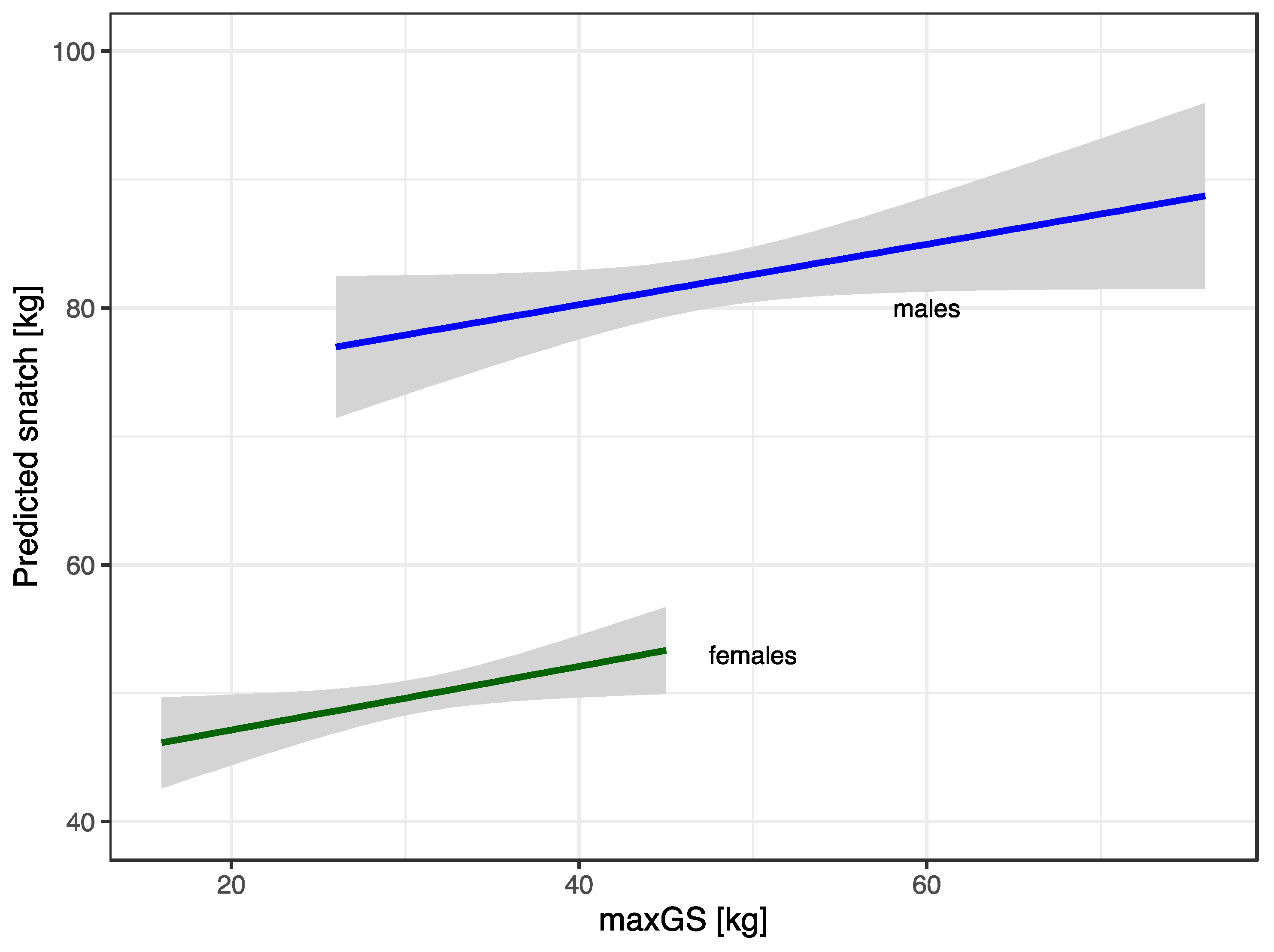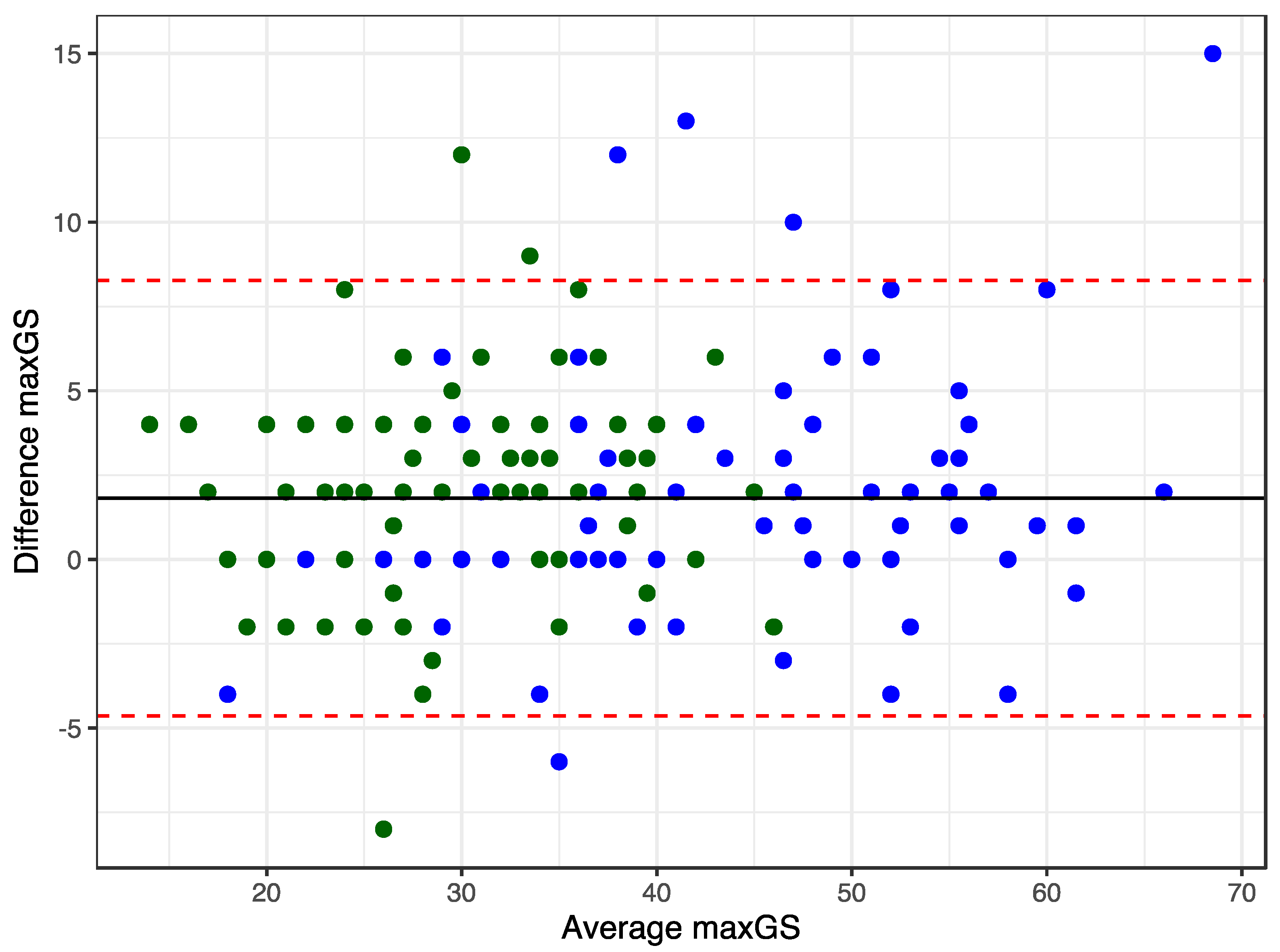Grip Strength and Sports Performance in Competitive Master Weightlifters
Abstract
1. Introduction
2. Materials and Methods
2.1. Study Participants
2.2. Measurements
2.3. Statistical Analysis
3. Results
4. Discussion
4.1. Age-Associated Decline in GS
4.2. GS and Weightlifting Performance
4.3. GS Asymmetry
5. Conclusions
Author Contributions
Funding
Institutional Review Board Statement
Informed Consent Statement
Data Availability Statement
Acknowledgments
Conflicts of Interest
References
- Storey, A.; Smith, H.K. Unique Aspects of Competitive Weightlifting: Performance, Training and Physiology. Sports Med. 2012, 42, 769–790. [Google Scholar] [CrossRef]
- Garhammer, J. Power Production by Olympic Weightlifters. Med. Sci. Sports Exerc. 1980, 12, 54–60. [Google Scholar] [CrossRef] [PubMed]
- Huebner, M.; Perperoglou, A. Performance Development from Youth to Senior and Age of Peak Performance in Olympic Weightlifting. Front. Physiol. 2019, 10, 1121. [Google Scholar] [CrossRef] [PubMed]
- Perperoglou, A.; Huebner, M. Quantile Foliation for Modeling Performance across Body Mass and Life Span in Olympic Weightlifting. Stat. Model. 2021, 21, 546–563. [Google Scholar] [CrossRef]
- Huebner, M.; Meltzer, D.E.; Perperoglou, A. Age-Associated Performance Decline and Sex Differences in Olympic Weightlifting. Med. Sci. Sports Exerc. 2019, 51, 2302–2308. [Google Scholar] [CrossRef] [PubMed]
- Gava, P.; Ravara, B. Master World Records Show Minor Gender Differences of Performance Decline with Aging. Eur. J. Transl. Myol. 2019, 29, 8327. [Google Scholar] [CrossRef]
- Anton, M.M.; Spirduso, W.W.; Tanaka, H. Age-Related Declines in Anaerobic Muscular Performance: Weightlifting and Powerlifting. Med. Sci. Sports Exerc. 2004, 36, 143–147. [Google Scholar] [CrossRef]
- Power, G.A.; Dalton, B.H.; Rice, C.L. Human Neuromuscular Structure and Function in Old Age: A Brief Review. J. Sport Health Sci. 2013, 2, 215–226. [Google Scholar] [CrossRef]
- Ahrenfeldt, L.J.; Scheel-Hincke, L.L.; Kjærgaard, S.; Möller, S.; Christensen, K.; Lindahl-Jacobsen, R. Gender Differences in Cognitive Function and Grip Strength: A Cross-National Comparison of Four European Regions. Eur. J. Public Health 2019, 29, 667–674. [Google Scholar] [CrossRef]
- Huebner, M.; Lawrence, F.; Lusa, L. Sex Differences in Age-Associated Rate of Decline in Grip Strength When Engaging in Vigorous Physical Activity. Int. J. Environ. Res. Public Health 2022, 19, 11009. [Google Scholar] [CrossRef]
- Lindle, R.S.; Metter, E.J.; Lynch, N.A.; Fleg, J.L.; Fozard, J.L.; Tobin, J.; Roy, T.A.; Hurley, B.F. Age and Gender Comparisons of Muscle Strength in 654 Women and Men Aged 20–93 Yr. J. Appl. Physiol. 1997, 83, 1581–1587. [Google Scholar] [CrossRef] [PubMed]
- Frederiksen, H.; Hjelmborg, J.; Mortensen, J.; McGue, M.; Vaupel, J.W.; Christensen, K. Age Trajectories of Grip Strength: Cross-Sectional and Longitudinal Data among 8,342 Danes Aged 46 to 102. Ann. Epidemiol. 2006, 16, 554–562. [Google Scholar] [CrossRef]
- McGrath, R.; Robinson-Lane, S.G.; Cook, S.; Clark, B.C.; Herrmann, S.; O’Connor, M.L.; Hackney, K.J. Handgrip Strength Is Associated with Poorer Cognitive Functioning in Aging Americans. J. Alzheimer’s Dis. 2019, 70, 1187–1196. [Google Scholar] [CrossRef] [PubMed]
- Wang, Y.-C.; Bohannon, R.W.; Li, X.; Sindhu, B.; Kapellusch, J. Hand-Grip Strength: Normative Reference Values and Equations for Individuals 18 to 85 Years of Age Residing in the United States. J. Orthop. Sports Phys. Ther. 2018, 48, 685–693. [Google Scholar] [CrossRef]
- McGrath, R.; Vincent, B.M.; Jurivich, D.A.; Hackney, K.J.; Tomkinson, G.R.; Dahl, L.J.; Clark, B.C. Handgrip Strength Asymmetry and Weakness Together Are Associated with Functional Disability in Aging Americans. J. Gerontol. A Biol. Sci. Med. Sci. 2021, 76, 291–296. [Google Scholar] [CrossRef] [PubMed]
- Collins, K.; Johnson, N.; Klawitter, L.; Waldera, R.; Stastny, S.; Kraemer, W.J.; Christensen, B.; McGrath, R. Handgrip Strength Asymmetry and Weakness Are Differentially Associated with Functional Limitations in Older Americans. Int. J. Environ. Res. Public Health 2020, 17, 3231. [Google Scholar] [CrossRef] [PubMed]
- Lin, S.; Wang, F.; Huang, Y.; Yuan, Y.; Huang, F.; Zhu, P. Handgrip Strength Weakness and Asymmetry Together Are Associated with Cardiovascular Outcomes in Older Outpatients: A Prospective Cohort Study. Geriatr. Gerontol. Int. 2022, 22, 759–765. [Google Scholar] [CrossRef]
- Cronin, J.; Lawton, T.; Harris, N.; Kilding, A.; McMaster, D.T. A Brief Review of Handgrip Strength and Sport Performance. J. Strength Cond. Res. 2017, 31, 3187–3217. [Google Scholar] [CrossRef] [PubMed]
- Fry, A.C.; Ciroslan, D.; Fry, M.D.; LeRoux, C.D.; Schilling, B.K.; Chiu, L.Z.F. Anthropometric and Performance Variables Discriminating Elite American Junior Men Weightlifters. J. Strength Cond. Res. 2006, 20, 861–866. [Google Scholar] [CrossRef]
- Jordre, B.; Schweinle, W. Hand Grip Strength in Senior Athletes: Normative Data and Community-Dwelling Comparisons. Int. J. Sports Phys. Ther. 2020, 15, 519–525. [Google Scholar] [CrossRef]
- Mathiowetz, V.; Weber, K.; Volland, G.; Kashman, N. Reliability and Validity of Grip and Pinch Strength Evaluations. J. Hand Surg. 1984, 9, 222–226. [Google Scholar] [CrossRef]
- Peolsson, A.; Hedlund, R.; Oberg, B. Intra- and Inter-Tester Reliability and Reference Values for Hand Strength. J. Rehabil. Med. 2001, 33, 36–41. [Google Scholar] [CrossRef] [PubMed]
- Sinclair, R.G. Normalizing the Performances of Athletes in Olympic Weightlifting. Can. J. Appl. Sport Sci 1985, 10, 94–98. [Google Scholar] [PubMed]
- Koenker, R.; Bassett, G. Regression Quantiles. Econometrica 1978, 46, 33–50. [Google Scholar] [CrossRef]
- Cohen, J. Statistical Power Analysis for the Behavioral Sciences; Routledge Academic: New York, NY, USA, 1988. [Google Scholar]
- Alley, D.E.; Shardell, M.D.; Peters, K.W.; McLean, R.R.; Dam, T.-T.L.; Kenny, A.M.; Fragala, M.S.; Harris, T.B.; Kiel, D.P.; Guralnik, J.M.; et al. Grip Strength Cutpoints for the Identification of Clinically Relevant Weakness. J. Gerontol. A Biol. Sci. Med. Sci. 2014, 69, 559–566. [Google Scholar] [CrossRef] [PubMed]
- Abe, T.; Thiebaud, R.S.; Loenneke, J.P. Age-Related Change in Handgrip Strength in Men and Women: Is Muscle Quality a Contributing Factor? Age 2016, 38, 28. [Google Scholar] [CrossRef]
- Oranchuk, D.J.; Drinkwater, E.J.; Lindsay, R.S.; Helms, E.R.; Harbour, E.T.; Storey, A.G. Improvement of Kinetic, Kinematic, and Qualitative Performance Variables of the Power Clean with the Hook Grip. Int. J. Sports Physiol. Perform. 2019, 14, 378–384. [Google Scholar] [CrossRef]
- Gast, U.; Belavý, D.L.; Armbrecht, G.; Kusy, K.; Lexy, H.; Rawer, R.; Rittweger, J.; Winwood, K.; Zieliński, J.; Felsenberg, D. Bone Density and Neuromuscular Function in Older Competitive Athletes Depend on Running Distance. Osteoporos. Int. 2013, 24, 2033–2042. [Google Scholar] [CrossRef]
- Labott, B.K.; Bucht, H.; Morat, M.; Morat, T.; Donath, L. Effects of Exercise Training on Handgrip Strength in Older Adults: A Meta-Analytical Review. Gerontology 2019, 65, 686–698. [Google Scholar] [CrossRef]
- Huebner, M.; Faber, F.; Currie, K.; Rieger, T. How Do Master Weightlifters Train? A Transnational Study of Weightlifting Training Practices and Concurrent Training. Int. J. Environ. Res. Public Health 2022, 19, 2708. [Google Scholar] [CrossRef]
- Mastalerz, A.; Szyszka, P.; Grantham, W.; Sadowski, J. Biomechanical Analysis of Successful and Unsuccessful Snatch Lifts in Elite Female Weightlifters. J. Hum. Kinet. 2019, 68, 69–79. [Google Scholar] [CrossRef]
- Gourgoulis, V.; Aggeloussis, N.; Garas, A.; Mavromatis, G. Unsuccessful vs. Successful Performance in Snatch Lifts: A Kinematic Approach. J. Strength Cond. Res. 2009, 23, 486–494. [Google Scholar] [CrossRef] [PubMed]
- Bull, F.C.; Al-Ansari, S.S.; Biddle, S.; Borodulin, K.; Buman, M.P.; Cardon, G.; Carty, C.; Chaput, J.-P.; Chastin, S.; Chou, R.; et al. World Health Organization 2020 Guidelines on Physical Activity and Sedentary Behaviour. Br. J. Sports Med. 2020, 54, 1451–1462. [Google Scholar] [CrossRef]
- Crosby, C.A.; Wehbé, M.A.; Mawr, B. Hand Strength: Normative Values. J. Hand Surg. 1994, 19, 665–670. [Google Scholar] [CrossRef]
- Iwańska, D.; Mróz, A.; Wójcik, A.; Witek, K.; Czajkowska, A.; Kusztelak, M. Strength Abilities in Men 50+ as an Effect of Long-Distance Run Training. Am. J. Men’s Health 2019, 13, 1557988319859108. [Google Scholar] [CrossRef]
- Burdukiewicz, A.; Pietraszewska, J.; Andrzejewska, J.; Chromik, K.; Stachoń, A. Asymmetry of Musculature and Hand Grip Strength in Bodybuilders and Martial Artists. Int. J. Environ. Res. Public Health 2020, 17, 4695. [Google Scholar] [CrossRef] [PubMed]
- Carson, R.G. Get a Grip: Individual Variations in Grip Strength Are a Marker of Brain Health. Neurobiol. Aging 2018, 71, 189–222. [Google Scholar] [CrossRef]
- Ward, N.S.; Swayne, O.B.C.; Newton, J.M. Age-Dependent Changes in the Neural Correlates of Force Modulation: An FMRI Study. Neurobiol. Aging 2008, 29, 1434–1446. [Google Scholar] [CrossRef] [PubMed]





| n | Females, n = 104 | Males, n = 64 | Overall, n = 168 | |
|---|---|---|---|---|
| Age, years | 168 | 51.8 ± 9.4 | 55.4 ± 13.6 | 53.1 ± 11.3 |
| Age at start of weightlifting, years | 163 | 43.2 ± 11.6 | 31.4 ± 15.4 | 38.9 ± 14.2 |
| Height, cm | 168 | 160.8 ± 7.2 | 171.4 ± 8.9 | 164.8 ± 9.4 |
| Body mass, kg | 168 | 68.1 ± 16.1 | 85.0 ± 14.6 | 74.5 ± 17.6 |
| BMI, kg/m2 | 168 | 26.1 ± 5.5 | 28.8 ± 3.5 | 27.2 ± 5.0 |
| Weekly training, hours | 161 | 8.3 ± 2.7 | 8.0 ± 2.7 | 8.2 ± 2.7 |
| Weekly other physical activities, hours | 161 | 4.3 ± 2.6 | 3.8 ± 2.1 | 4.1 ± 2.5 |
| PA low impact exercises, % | 164 | 71.0 75⁄104 | 60.0 36⁄60 | 67.7 111⁄164 |
| PA high impact exercises, % | 164 | 47.1 49⁄104 | 51.7 31⁄60 | 48.8 80⁄164 |
| PA strength exercises, % | 164 | 10.6 11⁄104 | 13.3 8⁄60 | 11.6 19⁄164 |
| SMF/SHMF | 168 | 197.1 ± 44.1 | 276.2 ± 108.6 | 227.2 ± 84.5 |
| MaxGS, kg | 168 | 30.7 ± 7.1 | 46.3 ± 11.5 | 37.02 ± 11.64 |
| MaxGS, newton | 168 | 301.2 ± 69.6 | 453.9 ± 112.5 | 359.3 ± 115.3 |
| GS ratio | 168 | 1.07 ± 0.10 | 1.04 ± 0.10 | 1.06 ± 0.10 |
| Hand/wrist injury in the last 12 months, % | 146 | 13.8 13⁄94 | 17.3 9⁄52 | 15.1 22⁄146 |
| Females, n = 103 | Males, n = 58 | |||
|---|---|---|---|---|
| coefficient (se) | p-value | coefficient (se) | p-value | |
| Intercept | −34.61 (13.47) | 0.012 | −28.22 (26.64) | 0.293 |
| Height | 0.47 (0.06) | <0.001 | 0.50 (0.14) | <0.001 |
| Age | −0.29 (0.06) | <0.001 | −0.30 (0.09) | 0.003 |
| Hours training | 0.26 (0.20) | 0.207 | 0.17 (0.47) | 0.723 |
| SMF/SHMF | 0.02 (0.01) | 0.167 | 0.06 (0.01) | 0.120 |
| Females, n = 101 | Males, n = 56 | |||
|---|---|---|---|---|
| Snatch | coefficient (se) | p-value | coefficient (se) | p-value |
| Intercept | 78.71 (6.84) | <0.001 | 91.54 (10.67) | <0.001 |
| MaxGS | 0.25 (0.11) | 0.028 | 0.23 (0.12) | 0.056 |
| Age | −1.01 (0.08) | <0.001 | −1.27 (0.09) | <0.001 |
| Body mass | 0.14 (0.04) | 0.002 | 0.343 (0.08) | <0.001 |
| Weekly training hours | 0.75 (0.26) | 0.004 | 1.74 (0.40) | <0.001 |
| Clean and jerk | ||||
| Intercept | 101.29 (7.81) | <0.001 | 148.85 (14.69) | <0.001 |
| MaxGS | 0.18 (0.13) | 0.155 | −0.25 (0.17) | 0.157 |
| Age | −1.23 (0.09) | <0.001 | −1.76 (0.12) | <0.001 |
| Body mass | 0.23 (0.05) | <0.001 | 0.62 (0.10) | <0.001 |
| Weekly training hours | 0.56 (0.29) | 0.059 | 1.50 (0.44) | <0.001 |
Disclaimer/Publisher’s Note: The statements, opinions and data contained in all publications are solely those of the individual author(s) and contributor(s) and not of MDPI and/or the editor(s). MDPI and/or the editor(s) disclaim responsibility for any injury to people or property resulting from any ideas, methods, instructions or products referred to in the content. |
© 2023 by the authors. Licensee MDPI, Basel, Switzerland. This article is an open access article distributed under the terms and conditions of the Creative Commons Attribution (CC BY) license (https://creativecommons.org/licenses/by/4.0/).
Share and Cite
Huebner, M.; Riemann, B.; Hatchett, A. Grip Strength and Sports Performance in Competitive Master Weightlifters. Int. J. Environ. Res. Public Health 2023, 20, 2033. https://doi.org/10.3390/ijerph20032033
Huebner M, Riemann B, Hatchett A. Grip Strength and Sports Performance in Competitive Master Weightlifters. International Journal of Environmental Research and Public Health. 2023; 20(3):2033. https://doi.org/10.3390/ijerph20032033
Chicago/Turabian StyleHuebner, Marianne, Bryan Riemann, and Andrew Hatchett. 2023. "Grip Strength and Sports Performance in Competitive Master Weightlifters" International Journal of Environmental Research and Public Health 20, no. 3: 2033. https://doi.org/10.3390/ijerph20032033
APA StyleHuebner, M., Riemann, B., & Hatchett, A. (2023). Grip Strength and Sports Performance in Competitive Master Weightlifters. International Journal of Environmental Research and Public Health, 20(3), 2033. https://doi.org/10.3390/ijerph20032033









